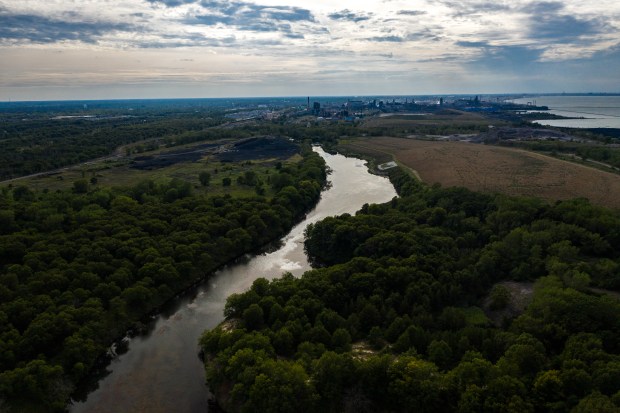Dirty air remains a chronic problem in the Chicago area.
Shortly before President Joe Biden left office, the U.S. Environmental Protection Agency reclassified the region from “moderate” to “serious” violations of federal regulations limiting lung-damaging smog, also known as ground-level ozone.
Better understanding about the dangers of particulate matter, commonly known as soot, prompted the Biden EPA to tighten federal standards, effectively requiring cleaner factories, power plants and vehicles.
Under normal circumstances, failure to take more aggressive action to clear the air could cost Illinois hundreds of millions of dollars in road-building funds and make it more difficult for polluters to obtain permits. Industry executives and regulators would hash out new plans to improve air quality.
But Donald Trump is president again.
Trump’s latest EPA administrator, former New York Republican congressman Lee Zeldin, is attempting to roll back regulations that have reduced emissions of brain-damaging mercury and lead, lung-damaging soot and cancer-causing chemicals, among other things.
Zeldin is encouraging polluters to email the EPA seeking exemptions from clean air regulations. Trump himself gets to decide if the exemptions are granted.
The Trump administration also is stifling efforts to counter the impacts of climate change, leaving the nation more vulnerable to extreme weather.
Decades of research confirm these threats to human health, wildlife and the economy. In response, Zeldin wants to eliminate the EPA’s science division and purge up to 75% of the people who work there, a move that would effectively kneecap the agency’s ability to hold polluters accountable.
“The news here is much worse than it seems,” William K. Reilly, who led the EPA under Republican President George H.W. Bush, said during a recent call with journalists.
Reilly and other former EPA leaders, both Republicans and Democrats, fear Trump is plummeting the United States back to the days of unchecked pollution at the behest of his campaign donors.
Illinois — and other Great Lakes states with a long history of industrial pollution — will suffer if hard-won protections are eliminated or weakened.
“When the next train derailment occurs, when the next hurricane hits, wildfires, when any of these disasters happen, if all these changes go through the government will not be there because we won’t have the resources and we won’t have the manpower,” Luis Antonio Flores, a chemist in the EPA’s Chicago office, said during a March 25 protest organized by the union for local agency workers.
Trump’s latest moves to gut the EPA are led by Zeldin, far-right ideologues in the White House and billionaire Elon Musk, whose companies Tesla and SpaceX have been fined by the agency for multiple violations of environmental laws. The mass firings and regulatory rollbacks come as scientists routinely determine pollution is far more damaging than previously thought.
For instance, lead is so harmful the EPA and the Centers for Disease Control and Prevention say there is no safe level of exposure. During the 1960s it took 65 micrograms of lead per deciliter of blood in a child to merit intervention by public health officials. Despite significant progress in reducing lead poisoning, there are more than 400,000 pipes made of the toxic metal connecting Chicago homes and two-flats to the municipal water system.

The U.S. historically is the world’s biggest emitter of carbon dioxide, the chief gas altering the planet’s climate. There now is widespread understanding that the buildup of heat-trapping gases in the atmosphere is making hurricanes, droughts and wildfires more intense. Last year there were 27 disasters in the U.S. with losses of $1 billion or greater, compared with three in 1980, adjusted for inflation.
EPA researchers also determined, and independent panels of scientists confirmed, that a gas called ethylene oxide, used to make chemicals and sterilize medical equipment, is responsible for some of the nation’s highest risks of cancer from breathing toxic air pollution.
Then there are more recently discovered threats, including forever chemicals, also known as PFAS, and microplastics that pass unfiltered through water treatment plants.
Chemical manufacturers are urging Trump to eliminate ethylene oxide regulations adopted by Biden and the first national limits on certain forever chemicals in drinking water. Industry lobbyists and Republicans in Congress also want Trump to reverse a Biden-era rule that added two PFAS to the federal Superfund law, a policy change that forces polluters, rather than taxpayers, to pay for cleanups.
“That portion of EPA’s responsibility has been handed to somebody who is dead set on (curbing regulation of) chemicals in production and doing nothing about PFAS,” said Gina McCarthy, who led the agency under President Barak Obama and served as a climate adviser to Biden.
During the past month, Zeldin, the new Trump EPA administrator, has unleashed a flurry of doublespeak insisting that gutting the agency will jump-start the economy and “roll back trillions in regulatory costs and hidden taxes on U.S. families” while continuing to protect the environment and human health.
“Today the green new scam ends,” Zeldin said of the administration’s plans, including reconsidering decades of science showing climate change endangers humanity. He called the EPA’s legal framework to address the crisis “the holy grail of climate change religion.”
Major business interests are on board.
“We have been working with the Trump administration to help bring commonsense reforms to the agency’s regulations that will provide certainty to businesses and reduce regulatory costs,” Marty Durbin, senior vice president at the U.S. Chamber of Commerce, said in a statement.
Contrary to Trump and Zeldin’s statements, former EPA leaders noted the national economy grew exponentially after the deluge of environmental laws enacted during the 1970s and 1990s, which were approved by bipartisan majorities in Congress.
Studies commissioned by the agency found the benefits of the Clean Air Act alone have exceeded costs by up to 90 times. Today cleaner air means fewer emergency room visits for Americans with asthma, fewer missed days of school and work and fewer early deaths, the studies have shown.
If the Trump/Zeldin rollbacks survive court challenges, every $1 million saved by polluters would impose $6 million in health-related costs, including increased rates of asthma, cancer and heart disease, according to another study by a group of former EPA officials who based their estimates on agency data.
“It’s going to take time to undo this damage and people are going to be hurt, particularly children, who are so much more susceptible to these pollutants than adults,” said Christine Todd Whitman, the former Republican governor of New Jersey who served as EPA administrator under President George W. Bush.
The agency’s successes in cleaning up the environment appear to be taken for granted.
By almost every measure, air, water and land in the Chicago area are in better shape than they were when Republican President Richard Nixon created the EPA in 1970. William Ruckelshaus, the agency’s first administrator, said it “has no obligation to promote agriculture or commerce; only the critical obligation to protect and enhance the environment.”

Lake Michigan and the Chicago River are significantly cleaner than they were a half-century ago, when images of burning rivers and lakes teeming with noxious algae galvanized the nation and prompted Congress to approve the Clean Water Act.
Every senator and all but one Republican member of the House of Representatives voted in favor of the 1970 Clean Air Act, which dramatically reduced smog and other toxic pollution throughout the country.
New cars emit far less pollution than older models, gasoline no longer is laden with lead, and diesel fuel contains fewer smog-forming chemicals. Scores of the oldest, dirtiest coal-fired power plants have been replaced by cleaner, less-expensive sources of energy.
“We need to get Republicans back to that understanding,” Whitman said. “But the public has to play a role.”
Much of the EPA’s early work focused on the Great Lakes, the source of drinking water for more than 30 million people in the U.S. and Canada. The agency had overwhelming public and political support at the time. Still, some polluters fiercely resisted efforts to clean up human waste and other pollutants that fouled waterways.
It took the federal government until 1977, five years after the Clean Water Act took effect, to secure a court decision forcing the U.S. Steel Gary Works to reduce the amount of industrial waste it dumped into Lake Michigan and the Grand Calumet River. The steel mill is still the lake’s biggest polluter, and as recently as 2007 the EPA intervened to prevent Indiana from scrapping or relaxing limits in the facility’s water pollution permit.
Federal money and legal pressure also are largely responsible for reducing the amount of sewage that cities once routinely dumped into the Great Lakes and for cleaning up the Chicago River to the point where the city built an elaborate riverwalk downtown and commissioned boathouses designed by celebrated architects.
Yet there are 26 sites on the Great Lakes with ongoing Superfund cleanups, including Waukegan Harbor and the Grand Calumet River. Beaches are still occasionally closed after sewage overflows, a sign that efforts to improve treatment plants and divert storm runoff are, at best, incomplete.

More than 158 million Americans, including 6 out of every 10 Illinoisans, get their drinking water from a utility where at least one forever chemical has been detected. Two versions of PFAS are so dangerous the EPA declared in 2022 there is no safe exposure. The chemicals build up in human blood, cause cancer and other diseases and take years to leave the body.
Federal courts blocked a vast majority of environmental rollbacks attempted during Trump’s first term. His administration won just 23% of cases, compared to an average success rate of 70% during previous presidencies, according to a New York University analysis.
A key question is whether we have entered a new era.
Last year the far-right Supreme Court reduced the power of the EPA and other federal agencies to adopt regulations unless lawmakers spell out the details. Several cases pending before the court could further hamstring the EPA’s ability to combat climate change and industrial pollution.
Republicans in Congress aren’t coming to the rescue. Unlike their predecessors in the 1970s, House Republicans have voted dozens of times to eliminate the EPA’s authorities.
“I see these (Trump administration) announcements as more like an environmental culture war at the expense of people’s health,” said Sam Sankar, an attorney with Earthjustice, a nonprofit group that won most of its lawsuits against the Trump EPA during the president’s first term. “What’s all the more terrifying for me is the president and Lee Zeldin are outright following this religion of deregulation.”
Trump has said environmental protection should be left to the states, ignoring the fact that Nixon created the U.S. EPA in part because federal officials had concluded states were incapable of holding polluters accountable or were unwilling to do so.
Gutting the EPA also would eliminate federal grants that keep most state environmental agencies operating. More than 44% of the Illinois EPA’s budget this year came from the federal government, according to state records.
“Reasonable businesses and industries have respected the limits on pollution that (the U.S.) EPA has put into place over the years,” said Debra Shore, who led the federal agency’s Chicago office under Biden. “They know that they’re better off when they’re good neighbors to people living in the communities where they operate.
“Power plants and chemical plants,” Shore said, “they just want a stable, secure environment and to know what the rules are and what the American people want and deserve: clean air, clean water and safe places to live.”
Chicago Tribune’s Adriana Pérez contributed.





